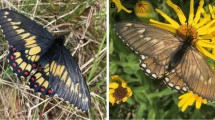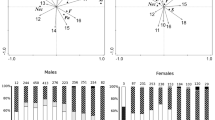Abstract
To assess bird predation pressure on butterflies, I investigated beak marks on the wings of two Lethe butterflies for 3 years in secondary temperate forests. If bird predation had significant effects on average longevity of butterflies, and if the number of specimens preyed upon was proportionate to the number of beak-marked specimens, the beak mark frequency would be negatively correlated with average longevity of a butterfly. Bird predation pressure is generally thought to influence average longevity of butterflies. Therefore, if there is a negative correlation between beak mark frequency and average longevity, bird predation pressure would be reflected in beak mark frequency. Beak mark frequency was negatively correlated with longevity in Lethe diana (Butler), the more abundant of the two species; thus, the beak mark frequency was considered to be a suitable index of bird predation pressure on the butterflies investigated in this study. In both Lethe species, beak mark frequency was higher in females than in males. Because female butterflies have a relatively smaller thorax and flight muscles and a larger abdomen that contains eggs, they are presumably weaker or less agile fliers than males, and are probably attacked more easily by birds. In autumn, butterflies were heavily attacked by birds irrespective of sex and species. Because the numbers of lepidopteran larvae, which are the preferred prey of many birds, decreased in autumn, birds were thought to shift their diets to alternative prey such as adult butterflies.


Similar content being viewed by others
References
Benson WW (1972) Natural selection for Müllerian mimicry in Heliconius erato in Costa Rica. Science 176:936–939
Berwaerts K, Van Dyck H, Aerts P (2002) Does flight morphology relate to flight performance? An experimental test with the butterfly Pararge aegeria. Funct Ecol 16:484–491
Bowers MD, Wiernasz DC (1979) Avian predation on the palatable butterfly, Cercyonis pegala (Satyridae). Ecol Entomol 4:205–209
Brakefield PM, Reitsma N (1991) Phenotypic plasticity, seasonal climate and the population biology of Bicyclus butterflies (Satyridae) in Malawi. Ecol Entomol 16:291–303
Brakefield PM, Shreeve TG, Thomas JA (1992) Avoidance, concealment, and defence. In: Dennis RLH (ed) The ecology of butterflies in Britain. Oxford University Press, Oxford, pp 93–119
Brown GP, Shine R (2004) Effects of reproduction on the antipredator tactics of snakes (Tropidonophis mairii, Colubridae). Behav Ecol Sociobiol 56:257–262
Burger J, Gochfeld M (2001) Smooth-billed ani (Crotophaga ani) predation on butterflies in Mato Grosso, Brazil: risk decreases with increased group size. Behav Ecol Sociobiol 49:482–492
Calvert WH, Hedrick LE, Brower LP (1979) Mortality of the monarch butterfly (Danaus plexippus L.): avian predation at five overwintering sites in Mexico. Science 204:847–851
Chai P, Srygley RB (1990) Predation and the flight, morphology and temperature of neotropical rain-forest butterflies. Am Nat 135:748–765
Darwin C (1871) The descent of man and selection in relation to sex. John Murray, London
Dempster JP (1984) The natural enemies of butterflies. In: Vane-Wright RI, Ackery PR (eds) The biology of butterflies. Princeton University Press, Princeton, N.J., pp 97–104
Edmunds M (1974a) Defence in animals. Longman, Harlow
Edmunds M (1974b) Significance of beak marks on butterfly wings. Oikos 25:117–118
Feeny P (1970) Seasonal changes in oak leaf tannins and nutrients as a cause of spring feeding by winter moth caterpillars. Ecology 51:565–581
Götmark F, Post P, Olsson J, Himmelmann D (1997) Natural selection and sexual dimorphism: sex-biased sparrowhawk predation favours crypsis in female chaffinches. Oikos 80:540–548
Gunnarsson B, Hake M (1999) Bird predation affects canopy-living arthropods in city parks. Can J Zool 77:1419–1428
Hasegawa H, Itô Y (1967) Biology of Hyphantria cunea Drury (Lepidoptera: Arctiidae) in Japan. I. Notes on adult biology with reference to the predation by birds. Appl Entomol Zool 2:100–110
Holmes RT, Schultz JC, Nothnagle P (1979) Bird predation on forest insects: an exclosure experiment. Science 206:462–463
Hori M, Noda T (2001) Spatio-temporal variation of avian foraging in the rocky intertidal food web. J Anim Ecol 70:122–137
Ide JY (2000) Seasonal change in flight behaviour of the satyrine butterfly Lethe diana (Lepidoptera: Nymphalidae). Entomol Sci 3:591–596
Ide JY (2001) Microhabitat differences in two Lethe butterflies (Lepidoptera: Nymphalidae) concerning thermoregulation. Entomol Sci 4:279–285
Ide JY (2002) Mating behaviour and light conditions cause seasonal changes in the dispersal pattern of the satyrine butterfly Lethe diana. Ecol Entomol 27:33–40
Ide JY (2004) Diurnal and seasonal changes in the mate-locating behavior of the satyrine butterfly Lethe diana. Ecol Res 19:189–196
Johki Y (1985) Wing damages of butterflies and birds’ attacks. Tyô Ga 35:202–207
Karban R (1982) Increased reproductive success at high densities and predator satiation for periodical cicadas. Ecology 63:321–328
Kassarov L (1999) Are birds able to taste and reject butterflies based on “beak mark tasting”? A different point of view. Behaviour 136:965–981
Korb J, Salewski V (2000) Predation on swarming termites by birds. Afr J Ecol 38:173–174
Kullberg C, Houston DC, Metcalfe NB (2002) Impaired flight ability—a cost of reproduction in female blue tits. Behav Ecol 13:575–579
Kuzu S (1934) Shijûkara-rui no syokusei ni kansuru chôsa seiseki. Chôjû Chôsa Hôkoku 7:35–122
Mallet J, Gilbert LE (1995) Why are there so many mimicry rings? Correlations between habitat, behaviour and mimicry in Heliconius butterflies. Biol J Linn Soc 55:159–180
Marden JH, Chai P (1991) Aerial predation and butterfly design: how palatability, mimicry, and the need for evasive flight constrain mass allocation. Am Nat 138:15–36
Marzluff JM, Kimsey BA, Schueck LS, McFadzen ME, Vekasy MS, Bednarz JC (1997) The influence of habitat, prey abundance, sex, and breeding success on the ranging behavior of Prairie Falcons. Condor 99:567–584
Murakami M (1998) Foraging habitat shift in the narcissus flycatcher, Ficedula narcissina, due to the response of herbivorous insects to the strengthening defenses of canopy trees. Ecol Res 13:73–82
Murakami M (2002) Foraging mode shifts of four insectivorous bird species under temporally varying resource distribution in a Japanese deciduous forest. Ornithol Sci 1:63–69
Nakano S, Murakami M (2001) Reciprocal subsidies: dynamic interdependence between terrestrial and aquatic food webs. Proc Natl Acad Sci USA 98:166–170
Nimura K (1991) Avifauna in the Kamigamo Experimental Forest of Kyoto University (in Japanese). Rep Kyoto Univ For 22:1–12
Nimura K (1992) Seasonal change of the avifauna in the Kamigamo Experimental Forest of Kyoto University (in Japanese). Rep Kyoto Univ For 23:1–9
Ohsaki N (1995) Preferential predation of female butterflies and the evolution of Batesian mimicry. Nature 378:173–175
Ohsaki N (2005) A common mechanism explaining the evolution of female-limited and both-sex Batesian mimicry in butterflies. J Anim Ecol 74:728–734
Osada N, Sugiura S, Kawamura K, Cho M, Takeda H (2003) Community-level flowering phenology and fruit set: comparative study of 25 woody species in a secondary forest in Japan. Ecol Res 18:711–723
Shaffer LR, Formanowicz DR Jr (1996) A cost of viviparity and parental care in scorpions: reduced sprint speed and behavioural compensation. Anim Behav 51:1017–1023
Shapiro AM (1974) Beak-mark frequency as an index of seasonal predation intensity on common butterflies. Am Nat 108:229–232
Smith DAS (1979) The significance of beak marks on the wings of an aposematic, distasteful and polymorphic butterfly. Nature 281:215–216
Srygley RB, Chai P (1990) Flight morphology of Neotropical butterflies: palatability and distribution of mass to the thorax and abdomen. Oecologia 84:491–499
Srygley RB, Dudley R (1993) Correlations of the position of center of body mass with butterfly escape tactics. J Exp Biol 174:155–166
Sweeney BW, Vannote RL (1982) Population synchrony in mayflies: a predator satiation hypothesis. Evolution 36:810–821
Thomas CD, Hill JK, Lewis OT (1998) Evolutionary consequences of habitat fragmentation in a localized butterfly. J Anim Ecol 67:485–497
Tsubuki T, Ueda K (2001) Significance of beak marks on butterfly wings: a review in Japan (in Japanese). Strix 19:129–140
Ueda K, Nasu Y, Suda Y (1981) Biological studies on Leucoma candida (Staudinger) (Lepidoptera, Lymantriidae) in Japan. III. Sparrow predation on adult moths. Res Popul Ecol 23:61–73
Veasey JS, Houston DC, Metcalfe NB (2001) A hidden cost of reproduction: the trade-off between clutch size and escape take-off speed in female zebra finches. J Anim Ecol 70:20–24
Watt WB, Chew FS, Snyder LRG, Watt AG, Rothschild DE (1977) Population structure of pierid butterflies. I. Numbers and movements of some montane Colias species. Oecologia 27:1–22
Wickler W (1968) Mimicry in plants and animals. McGraw-Hill, New York
Wourms MK, Wasserman FE (1985) Bird predation on Lepidoptera and the reliability of beak-marks in determining predation pressure. J Lepid Soc 39:239–261
Yoshida K (1985) Seasonal population trends of macrolepidopterous larvae on oak trees in Hokkaido, Northern Japan. Kontyû 53:125–133
Yui M (1988) Mori ni sumu yachô no seitaigaku. Sôbun, Tokyo
Acknowledgements
I thank Dr N. Ohsaki for his critical reading of the manuscript, Ms. K. Tsurui for her helpful comment on the list of possible bird predators, and members of the Laboratory of Insect Ecology and the Laboratory of Ecological Information, Graduate School of Agriculture, Kyoto University, for their discussion and comments. I further thank the Kamigamo Experimental Forest Station, Graduate School of Agriculture, Kyoto University, for permission to conduct this research.
Author information
Authors and Affiliations
Corresponding author
About this article
Cite this article
Ide, JY. Sexual and seasonal differences in the frequency of beak marks on the wings of two Lethe butterflies. Ecol Res 21, 453–459 (2006). https://doi.org/10.1007/s11284-005-0140-z
Received:
Accepted:
Published:
Issue Date:
DOI: https://doi.org/10.1007/s11284-005-0140-z




